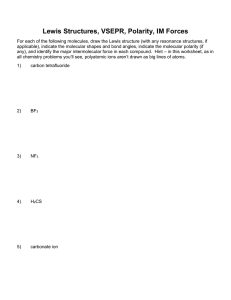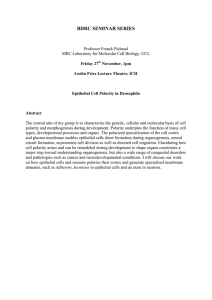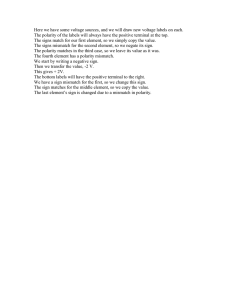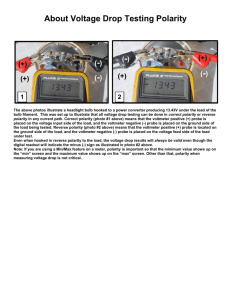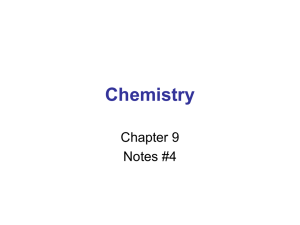Sentiment Analysis Using Dependency Trees and Named-Entities
advertisement
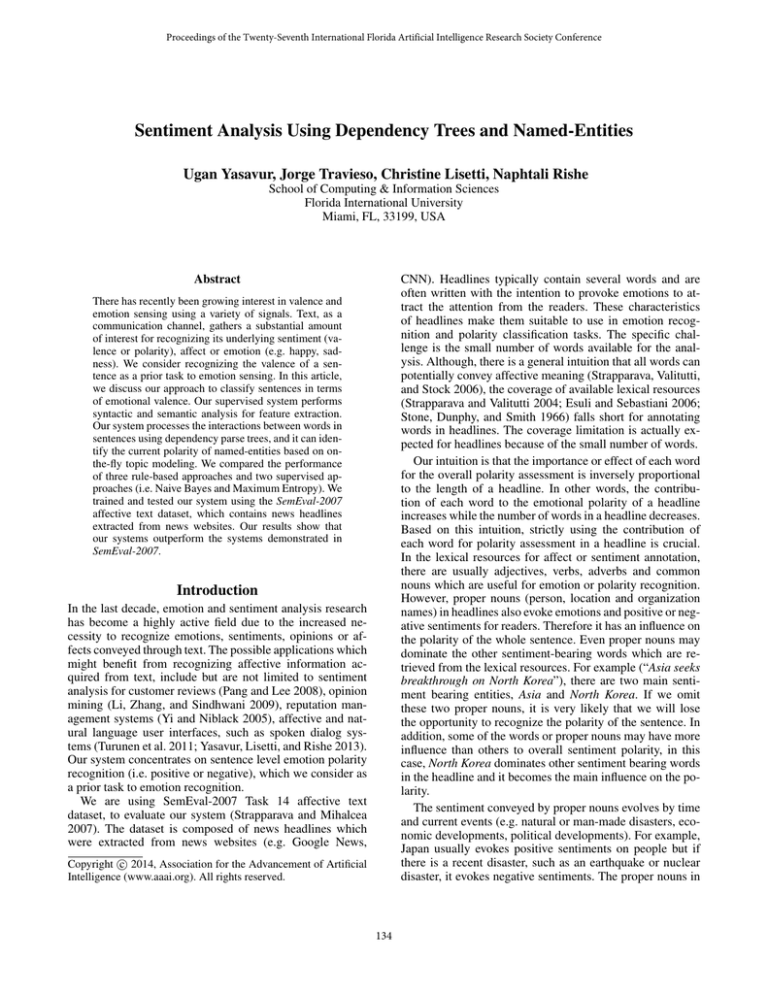
Proceedings of the Twenty-Seventh International Florida Artificial Intelligence Research Society Conference
Sentiment Analysis Using Dependency Trees and Named-Entities
Ugan Yasavur, Jorge Travieso, Christine Lisetti, Naphtali Rishe
School of Computing & Information Sciences
Florida International University
Miami, FL, 33199, USA
Abstract
CNN). Headlines typically contain several words and are
often written with the intention to provoke emotions to attract the attention from the readers. These characteristics
of headlines make them suitable to use in emotion recognition and polarity classification tasks. The specific challenge is the small number of words available for the analysis. Although, there is a general intuition that all words can
potentially convey affective meaning (Strapparava, Valitutti,
and Stock 2006), the coverage of available lexical resources
(Strapparava and Valitutti 2004; Esuli and Sebastiani 2006;
Stone, Dunphy, and Smith 1966) falls short for annotating
words in headlines. The coverage limitation is actually expected for headlines because of the small number of words.
Our intuition is that the importance or effect of each word
for the overall polarity assessment is inversely proportional
to the length of a headline. In other words, the contribution of each word to the emotional polarity of a headline
increases while the number of words in a headline decreases.
Based on this intuition, strictly using the contribution of
each word for polarity assessment in a headline is crucial.
In the lexical resources for affect or sentiment annotation,
there are usually adjectives, verbs, adverbs and common
nouns which are useful for emotion or polarity recognition.
However, proper nouns (person, location and organization
names) in headlines also evoke emotions and positive or negative sentiments for readers. Therefore it has an influence on
the polarity of the whole sentence. Even proper nouns may
dominate the other sentiment-bearing words which are retrieved from the lexical resources. For example (“Asia seeks
breakthrough on North Korea”), there are two main sentiment bearing entities, Asia and North Korea. If we omit
these two proper nouns, it is very likely that we will lose
the opportunity to recognize the polarity of the sentence. In
addition, some of the words or proper nouns may have more
influence than others to overall sentiment polarity, in this
case, North Korea dominates other sentiment bearing words
in the headline and it becomes the main influence on the polarity.
The sentiment conveyed by proper nouns evolves by time
and current events (e.g. natural or man-made disasters, economic developments, political developments). For example,
Japan usually evokes positive sentiments on people but if
there is a recent disaster, such as an earthquake or nuclear
disaster, it evokes negative sentiments. The proper nouns in
There has recently been growing interest in valence and
emotion sensing using a variety of signals. Text, as a
communication channel, gathers a substantial amount
of interest for recognizing its underlying sentiment (valence or polarity), affect or emotion (e.g. happy, sadness). We consider recognizing the valence of a sentence as a prior task to emotion sensing. In this article,
we discuss our approach to classify sentences in terms
of emotional valence. Our supervised system performs
syntactic and semantic analysis for feature extraction.
Our system processes the interactions between words in
sentences using dependency parse trees, and it can identify the current polarity of named-entities based on onthe-fly topic modeling. We compared the performance
of three rule-based approaches and two supervised approaches (i.e. Naive Bayes and Maximum Entropy). We
trained and tested our system using the SemEval-2007
affective text dataset, which contains news headlines
extracted from news websites. Our results show that
our systems outperform the systems demonstrated in
SemEval-2007.
Introduction
In the last decade, emotion and sentiment analysis research
has become a highly active field due to the increased necessity to recognize emotions, sentiments, opinions or affects conveyed through text. The possible applications which
might benefit from recognizing affective information acquired from text, include but are not limited to sentiment
analysis for customer reviews (Pang and Lee 2008), opinion
mining (Li, Zhang, and Sindhwani 2009), reputation management systems (Yi and Niblack 2005), affective and natural language user interfaces, such as spoken dialog systems (Turunen et al. 2011; Yasavur, Lisetti, and Rishe 2013).
Our system concentrates on sentence level emotion polarity
recognition (i.e. positive or negative), which we consider as
a prior task to emotion recognition.
We are using SemEval-2007 Task 14 affective text
dataset, to evaluate our system (Strapparava and Mihalcea
2007). The dataset is composed of news headlines which
were extracted from news websites (e.g. Google News,
c 2014, Association for the Advancement of Artificial
Copyright Intelligence (www.aaai.org). All rights reserved.
134
Figure 1: Dependencies
and three systems for emotion labeling. The CLAC system used a knowledge-based, domain-independent, unsupervised approach (Andreevskaia and Bergler 2007). It uses
3 knowledge sources, a list of sentiment-bearing words, a
list of polarity reversal words, and a set of rules that define the results of combination of sentiment-bearing words
with polarity reversal words. The CLAC-NB system uses
a Naive Bayes classifier without feature extraction to assess the performance of this basic machine learning technique (Andreevskaia and Bergler 2007). The UPAR7 system (Chaumartin 2007) used a rule-based approach, where
a list of words for high tech acronyms, celebrities was used
in addition to SentiWordNet (Esuli and Sebastiani 2006) and
WordNetAffect (Strapparava and Valitutti 2004) lexical resources.The SICS used a valence annotation approach based
on a word-space model and set of seed words which is based
on the idea of creating two points in a high-dimensional
word space, one representing positive valence, the other
representing negative valence, and projecting each headline
into this space (Sahlgren, Karlgren, and Eriksson 2007).
The SWAT system used a supervised methodology by implementing an uni-gram model trained to annotate. Moreover, they added an additional set of 1000 headlines for
training (Katz, Singleton, and Wicentowski 2007). Therefore, the demonstrated systems in SemEval-2007 (Strapparava and Mihalcea 2007), did not consider the contribution of
sentiment-bearing named-entities. Since the news headlines
very commonly contain proper nouns, there is a good chance
to improve the reported results, if the proper names are used
in sentiment polarity determination.
sentences can be identified by any standard named entity
recognizers (Finkel, Grenager, and Manning 2005) which
can recognize location, person and organization entities. The
real difficulty is deciding the current sentiment polarity of
the recognized named entities. We addressed this problem
in our system which is discussed in the Approach section.
In sentiment polarity recognition, a sentence might contain positive or negative polarity words, but a sentence does
not necessarily have the same polarity as a whole. To take
into account the interactions between words instead of handling the words independently, our system implements dependency parsing and some linguistics rules, such as polarity reversal.
Related Work
Sentiment analysis has gathered the attention of many research groups from variety of areas, such as affective computing, linguistics and psychology. There is a substantial amount of work done using different approaches, that
can be categorized in 2 main categories (i.e. rule-based
and statistical approaches). Ruled-based systems usually try
to apply linguistic compositionality rules (Neviarouskaya,
Prendinger, and Ishizuka 2011) and create highly comprehensive lexicons (i.e. in conjunction with possible compositionality rules) (Neviarouskaya, Prendinger, and Ishizuka
2009) to perform sentiment analysis on text at sentence
and phrase level. Machine learning approaches are also frequently applied to the sentiment analysis problem, such as
linguistically inspired deep neural networks (Socher et al.
2013), graphical models (Nakagawa, Inui, and Kurohashi
2010) and classical supervised learning techniques (Alm,
Roth, and Sproat 2005). In addition, micro-blogging websites also get the attention of researchers for sentiment analysis (Pak and Paroubek 2010; Kouloumpis, Wilson, and
Moore 2011). In these studies, emoticons, as a different
modality, are used for sentiment polarity recognition. In
this paper, we discuss and compare our model to the systems presented at SemEval-2007, where the same corpus of
news headlines was used. Our main emphasis is on affect of
named-entities and prevalent compositionality in headlines.
Five teams participated to SemEval-2007 Task-14: Affective Text, with five systems for valence classification
Approach
We used five different approaches for classification after
performing the feature extraction. We are using the Stanford dependency parser (De Marneffe et al. 2006), the partof-speech tagger (Toutanova et al. 2003) and the namedentity recognizer (Finkel, Grenager, and Manning 2005) as
software packages for feature extraction. We use MPQA
Opinion Corpus (Wilson, Wiebe, and Hoffmann 2005) and
General Inquirer (Stone, Dunphy, and Smith 1966) as lexical resources to identify sentiment orientation of words.
To process the interaction between words, our system uses
135
Figure 2: System Architecture
was tagged using the sentiment polarity lexical resources.
The topic model polarity decider component selects the aggregated overall polarity of a topic which actually represents
the recognized named-entity. We are using a simple algorithm to decide the overall polarity. If the polarity of a word
is positive, it adds 1. If it is negative it subtracts 1, if it is
neutral, it does nothing. If the aggregated polarity is greater
than 0, the polarity of named-entity is positive. If it is less
than 0, the polarity of named-entity is negative.
For example, in Figure 1, Gaza (city name) is identified
as a named-entity. Since it is a proper noun, it does not exist
in our lexical resources. Our system would search the web to
retrieve 30 news articles about Gaza and perform topic modeling on them to obtain the related word set. Our topic modeling component identified ”Israel, air strike, attack, bomb,
war, Hamas, terror, refugee, crisis, rocket” as top 10 words.
As previously stated, our system searches for 30 words, all
of which are then annotated using our lexical resources. Afterwards, the polarity score for the Gaza named-entity is automatically determined as negative using the previous algorithm.
dependency parsing. The named-entity recognizer is used
to recognize locations, organizations (e.g. company names,
acronyms) and person names. Then, the syntactic parser is
used for word-level analysis. The flow of information among
the components of the system is depicted in Figure 2.
Named-Entities and Topic Modeling
We observed that most of the news headlines (82% of SemEval DataSet) contain named-entities which influence the
overall sentiment polarity of each headline. Therefore, we
needed to consider the influence of a named-entity to the
overall polarity for an accurate sentiment classification. We
are using the Stanford named-entity recognizer to find locations (e.g. Middle East, Gaza), organization names (e.g.
Apple, Google, European Union) and person names (e.g.
Obama, Madonna), all of which are named-entities. However, the real difficulty is, there is no lexical resource to
annotate identified named-entities with the polarity information. To address this problem of finding the sentiment
valence for named entities, we performed topic modeling
on web news resources (i.e. Google News, CNN). As we
showed in Figure 2, with each identified named-entity, the
system searches on the web to find news articles and gathers
top 30 most relevant news articles to the searched namedentity. Then the system performs topic modeling on the news
articles retrieved from the web.
Topic modeling provides a simple way to analyze large
volumes of unlabeled text. A ”topic” consists of a cluster of
words that frequently occur together. Using contextual clues,
topic models can connect words with similar meanings and
distinguish between uses of words with multiple meanings.
We used the Mallet1 library for topic modeling.
A topic model with a cluster of 30 words derived from 30
news articles was retrieved from the web. In other words, we
represented the recognized named-entity with 30 words to
decide the polarity of the named-entity. The cluster of words
1
Features and Interactions Between Words
The polarity of a whole sentence can not be calculated without considering interactions between words, as it can be seen
in Figure 1 for the sentence ”Kidnapped AP photographer
freed in Gaza”. There are two negative words (kidnapped,
Gaza) and one positive polarity reversal word (freed). If the
text is analyzed without considering interactions between
words and dependencies, it is very likely that the results
might end up with a negative classification. However, as it
can be seen in Figure 1, even though sub-trees bears negative sentiment, the word ”freed” reverses the polarity of the
whole sentence.
Our system uses two types of features, node features and
edge features. Node features represent each node in dependency tree, and edge features represent the interactions between words. Node features include the prior polarity of a
http://mallet.cs.umass.edu/
136
Node Features
a ti
b ti &mi
c ti &mi &ri
d ti &si
e ti &ci
f ti &fi
Dependency Features
A tg &td
B tg &td &rd
C tg &td &rd &md
D tg &td &cg &cd &R
Table 2: Dependency Features
Table 1: Node Features
teractions between words, we used rule-based and supervised systems to decide the polarity label of a sentence and
compare the results.
word which can be obtained from our lexical resources, polarity reversal, resulting polarity and pos-tag. Edge features
represent interaction between sub-trees. For example, in Figure 1, kidnapped is negative, AP is neutral which is an organization name, photographer is neutral, the negative polarity
of kidnapped propagates to the sub-tree where photogtapher
is the root. Our system not only uses the tree structure for
word interactions, but also uses dependencies. For this case,
the first dependency, directly shows the relationship between
the words photographer and kidnapped. For the entity Gaza,
our system uses topic modeling, explained in the NamedEntities and Topic Modeling section that yielded a negative
polarity. However, the word freed reverses the meaning of
the whole sentence.
The polarity reversal feature of a node ri {0, 1}, represents whether or not it reverses the polarity of other words.
A polarity reversal word list was prepared so that the property ri in identified words it is set to 1 otherwise it is 0.
The described list was constructed from General Inquirer
in the same methodology used in (Choi and Cardie 2008).
We collected words which belong to either NOTLW or DECREAS categories from General Inquirer (the dictionary
contains 121 polarity reversing words). Choi and Cardie categorized polarity reversal words into two distinct categories:
function-word negators, such as not, and content-word negators, such as eliminate. The polarity reversal of a phrase handles only content-word negators, and function-word negators are handled based on the result of Stanford dependency
parser which gives the negation (neg) relation directly.
In Table 1 and Table 2, we show the features we used
in this project. Features (a)-(f) in Table 1 represents node
features for the i-th word, which is a node in the dependency tree. In Table 1, ti denotes polarity of a node, mi
denotes prior polarity of a node. Prior polarity of a node
mi {+1, 0, −1} is the innate sentiment of a word obtained
from the polarity lexical resources. As described before ri
represents polarity reversal word, si denotes surface form,
ci denotes coarse-grained part-of-speech (POS) tag, fi denotes fine-grained POS tag. Features (A)-(D) in Table 2 represents dependency features for each dependency governor
(head) and its dependent. In Table 2, tg denotes polarity of
governor, td denotes polarity of dependent, rd polarity reversal word for dependent, md denotes prior polarity as in
node features table, cg denotes coarse-grained pos tag for
governor, cd denotes coarse-grained polarity tag for dependent and R denotes the dependency relationship type (e.g.
negation).
After feature extraction including named-entities and in-
Experiments
We conducted the experiments of sentiment classification in
SemEval 2007 Affective text news headline corpora.
Data
The dataset consisted of news headlines from major news
resources such as New York Times, CNN, and BBC News.
The headlines are collected for two main reasons. First, the
high load of emotional content, as they describe major national or worldwide events and are written in a style meant
to attract the attention of the readers. Second, the structure
of headlines was appropriate to make sentence-level annotations of emotions. Two different annotated datasets were
made available: one is a development dataset consisting of
250 headlines, and the other with 1,000 headlines. For our
experiments we only use valence (positive/negative annotation). The interval for the valence annotations was set to
[-100, 100], where 0 represents a neutral headline, -100 represents a highly negative headline, and 100 corresponds to a
highly positive headline. Even though, annotations are finegrained, we used coarse-grained annotations with positive
[50, 100], negative [-100, -50] and neutral (-50, 50). Moreover, we used 750 headlines for training and 500 headlines
for testing.
It was reported that the test dataset was independently labeled by six annotators, who were instructed to select the
appropriate emotions for each headline based on the presence of words or phrases with emotional content, as well as
the sentiment polarity invoked by the headline. The agreement evaluations were conducted using the Pearson correlation measure, with an inter-annotator agreement of 78.01.
Compared Methods
We compared five methods with a different set of features, 3
rule-based methods as used in (Nakagawa, Inui, and Kurohashi 2010) without using major polarity in training data and
2 supervised classification methods (Naive Bayes and Maximum Entropy) described below. Ai denotes the set of all
the ancestor nodes of i-th word in the dependency tree, and
val(x) is defined as:
+1, (x > 1),
val(x) = −1, (x < 0),
0
(x = 0).
137
Method
Voting w/o PR
Voting w/ PR
Rule
Naı̈ve Bayes
Maximum Entropy
Acc.
0.6613
0.6253
0.644
0.6606
0.7673
Prec.
0.4916
0.4553
0.4855
0.4921
0.5849
Rec.
0.5378
0.5191
0.6195
0.6461
0.7411
F1
0.5103
0.4851
0.5394
0.5564
0.6518
The performance of the rule-based approaches is close
to each other, the Naive Bayes approach performed slightly
better than the rule-based approaches. The Maximum Entropy classifier achieved better results compared to the other
4 methods.
When we compare our results with the accuracy of the
systems presented in SemEval-2007 Affective Text task
(Strapparava and Mihalcea 2007), our methodology outperformed the demonstrated systems. The highest reported accuracy and F1 score in SemEval are 0.5510 and 0.4243 respectively. Our best performing system’s (i.e. maximumentropy classifier) accuracy and F1 score are 0.7673 and
0.6518 (see Table 3) respectively. We believe that the main
factor in improvement is taking into account the polarity information of the named-entities by performing topic modeling on news articles. It is easily observable that in news
headlines there are many proper names and named entities,
and the number of the words in each headline is little. If
a system does not use sentiment polarity information for a
named-entity, it skips important information for overall polarity of a headline. As we discuss in the Named-Entities and
Topic Modeling Section, upon running the Stanford namedentity recognizer on the trial data provided in SemEval-2007
for example, we find that 82% percent of the headlines contain at least one named-entity.
Table 3: Experiment Results. First column is method used,
second column is accuracy, third column is precision, fourth
column is recall and fifth column is F-1 score. PR stands for
polarity reversal.
Voting without Polarity Reversal The polarity of the
headline is decided by voting of each node’s prior/innate
polarity which also includes polarity of each named-entity
which is obtained through topic modeling.
n
X
p = val(
mi )
(1)
i=1
Voting with Polarity Reversal Similar to Voting without
polarity reversal, except that the polarities of phrases which
have odd numbers of reversal phrases in their ancestors are
reversed before voting.
n
X
Y
mi
(−1)rj )
p = val(
i=1
Conclusion
(2)
In this paper, we presented our approach and experiments to
perform sentiment polarity classification on the SemEval2007 Affective Text data. Our system used some of the
available sentiment polarity lexical resources and polarity
reversal words for feature extraction. Also we performed
topic modeling to decide sentiment polarity of each namedentity. Our approach shows that the consideration of namedentities has a positive effect on sentiment polarity classification. Our approaches outperformed the systems presented in
SemEval-2007. Although we did not test it, we believe that
our system can be used in other domains for sentence level
sentiment polarity classification. As a future research, we
are planning to test our system on different domains, such as
movies reviews datasets.
jAi
Rule The sentiment polarity of a headline is deterministically decided based on rules, by considering the polarities
of sub-trees. The polarity of the sub-tree whose ancestor is
the i-th word is decided by voting the prior polarity of the
i-th word and the polarities of the sub-trees whose ancestor
nodes are the modifiers of the i-th word. The polarities of the
modifiers are reversed if their governor phrase had a reversal word. The decision rule is applied from bottom to top,
the polarity of root node is decided at last.
X
p = val(mi +
ti (−1)ri )
(3)
j:hj =i
Supervised Classification We have used the Naive Bayes
and Maximum Entropy methods for classification using the
Mallet machine learning package. It is important to note that
we used 750 news headlines as a training data and 500 as
testing data.
Acknowledgments
This material is based in part upon work supported by
the National Science Foundation under Grant Nos. SBIR
IIP-1256641, SBIR IIP-1118610, I/UCRC IIP-1338922,
AIR IIP-1237818, CREST HRD-0833093, I/UCRC IIP0829576.
Experiment Results
We have conducted the experiments using five different approaches. We presented our results in Table 3. The table
columns from left to right shows, method used to decide polarity of a headline, accuracy, precision, recall and F1 measure. The performance of each method is measured with
accuracy and Fβ rate as shown in Equation 4 (Rijsbergen
1979).
Fβ =
(β 2 + 1) ∗ precision ∗ recall
β 2 ∗ precision + recall
References
Alm, C. O.; Roth, D.; and Sproat, R. 2005. Emotions from
text: machine learning for text-based emotion prediction. In
Proceedings of the conference on Human Language Technology and Empirical Methods in Natural Language Processing, 579–586. Association for Computational Linguistics.
Andreevskaia, A., and Bergler, S. 2007. Clac and clacnb: Knowledge-based and corpus-based approaches to sen-
(4)
138
sensing from text. Natural Language Engineering 17(1):95–
135.
Pak, A., and Paroubek, P. 2010. Twitter as a corpus for
sentiment analysis and opinion mining. In LREC.
Pang, B., and Lee, L. 2008. Opinion mining and sentiment
analysis. Foundations and trends in information retrieval
2(1-2):1–135.
Rijsbergen, C. J. V. 1979. Information Retrieval. Newton,
MA, USA: Butterworth-Heinemann, 2nd edition.
Sahlgren, M.; Karlgren, J.; and Eriksson, G. 2007. Sics:
Valence annotation based on seeds in word space. In Proceedings of the Fourth International Workshop on Semantic
Evaluations (SemEval-2007), 296–299. Prague, Czech Republic: Association for Computational Linguistics.
Socher, R.; Perelygin, A.; Wu, J. Y.; Chuang, J.; Manning,
C. D.; Ng, A. Y.; and Potts, C. 2013. Recursive deep models for semantic compositionality over a sentiment treebank.
In Proceedings of the Conference on Empirical Methods in
Natural Language Processing (EMNLP), 1631–1642.
Stone, P. J.; Dunphy, D. C.; and Smith, M. S. 1966. The
general inquirer: A computer approach to content analysis.
Strapparava, C., and Mihalcea, R. 2007. Semeval-2007 task
14: Affective text. In Proceedings of the 4th International
Workshop on Semantic Evaluations, 70–74. Association for
Computational Linguistics.
Strapparava, C., and Valitutti, A. 2004. Wordnet affect: an
affective extension of wordnet. In LREC, volume 4, 1083–
1086.
Strapparava, C.; Valitutti, A.; and Stock, O. 2006. The affective weight of lexicon. In Proceedings of the Fifth International Conference on Language Resources and Evaluation,
423–426.
Toutanova, K.; Klein, D.; Manning, C. D.; and Singer, Y.
2003. Feature-rich part-of-speech tagging with a cyclic dependency network. In Proceedings of the 2003 Conference
of the North American Chapter of the Association for Computational Linguistics on Human Language TechnologyVolume 1, 173–180. Association for Computational Linguistics.
Turunen, M.; Hakulinen, J.; Ståhl, O.; Gambäck, B.;
Hansen, P.; Rodrı́guez Gancedo, M. C.; de la Cámara, R. S.;
Smith, C.; Charlton, D.; and Cavazza, M. 2011. Multimodal
and mobile conversational health and fitness companions.
Computer Speech & Language 25(2):192–209.
Wilson, T.; Wiebe, J.; and Hoffmann, P. 2005. Recognizing
contextual polarity in phrase-level sentiment analysis. In
Proceedings of the conference on Human Language Technology and Empirical Methods in Natural Language Processing, 347–354. Association for Computational Linguistics.
Yasavur, U.; Lisetti, C.; and Rishe, N. 2013. Modeling
brief alcohol intervention dialogue with mdps for delivery
by ecas. In Intelligent Virtual Agents, 92–105. Springer.
Yi, J., and Niblack, W. 2005. Sentiment mining in webfountain. In Data Engineering, 2005. ICDE 2005. Proceedings.
21st International Conference on, 1073–1083. IEEE.
timent tagging. In Proceedings of the Fourth International
Workshop on Semantic Evaluations (SemEval-2007), 117–
120. Prague, Czech Republic: Association for Computational Linguistics.
Chaumartin, F.-R. 2007. Upar7: A knowledge-based system
for headline sentiment tagging. In Proceedings of the Fourth
International Workshop on Semantic Evaluations (SemEval2007), 422–425. Prague, Czech Republic: Association for
Computational Linguistics.
Choi, Y., and Cardie, C. 2008. Learning with compositional
semantics as structural inference for subsentential sentiment
analysis. In Proceedings of the Conference on Empirical
Methods in Natural Language Processing, 793–801. Association for Computational Linguistics.
De Marneffe, M.-C.; MacCartney, B.; Manning, C. D.; et al.
2006. Generating typed dependency parses from phrase
structure parses. In Proceedings of LREC, volume 6, 449–
454.
Esuli, A., and Sebastiani, F. 2006. Sentiwordnet: A publicly
available lexical resource for opinion mining. In Proceedings of LREC, volume 6, 417–422.
Finkel, J. R.; Grenager, T.; and Manning, C. 2005. Incorporating non-local information into information extraction
systems by gibbs sampling. In Proceedings of the 43rd Annual Meeting on Association for Computational Linguistics,
363–370. Association for Computational Linguistics.
Katz, P.; Singleton, M.; and Wicentowski, R. 2007. Swatmp:the semeval-2007 systems for task 5 and task 14. In Proceedings of the Fourth International Workshop on Semantic
Evaluations (SemEval-2007), 308–313. Prague, Czech Republic: Association for Computational Linguistics.
Kouloumpis, E.; Wilson, T.; and Moore, J. 2011. Twitter sentiment analysis: The good the bad and the omg! In
ICWSM.
Li, T.; Zhang, Y.; and Sindhwani, V. 2009. A non-negative
matrix tri-factorization approach to sentiment classification
with lexical prior knowledge. In Proceedings of the Joint
Conference of the 47th Annual Meeting of the ACL and
the 4th International Joint Conference on Natural Language
Processing of the AFNLP: Volume 1 - Volume 1, ACL ’09,
244–252. Stroudsburg, PA, USA: Association for Computational Linguistics.
Nakagawa, T.; Inui, K.; and Kurohashi, S. 2010. Dependency tree-based sentiment classification using crfs with
hidden variables. In Human Language Technologies: The
2010 Annual Conference of the North American Chapter
of the Association for Computational Linguistics, 786–794.
Association for Computational Linguistics.
Neviarouskaya, A.; Prendinger, H.; and Ishizuka, M. 2009.
Sentiful: Generating a reliable lexicon for sentiment analysis. In Affective Computing and Intelligent Interaction and
Workshops, 2009. ACII 2009. 3rd International Conference
on, 1–6. IEEE.
Neviarouskaya, A.; Prendinger, H.; and Ishizuka, M. 2011.
Affect analysis model: novel rule-based approach to affect
139

